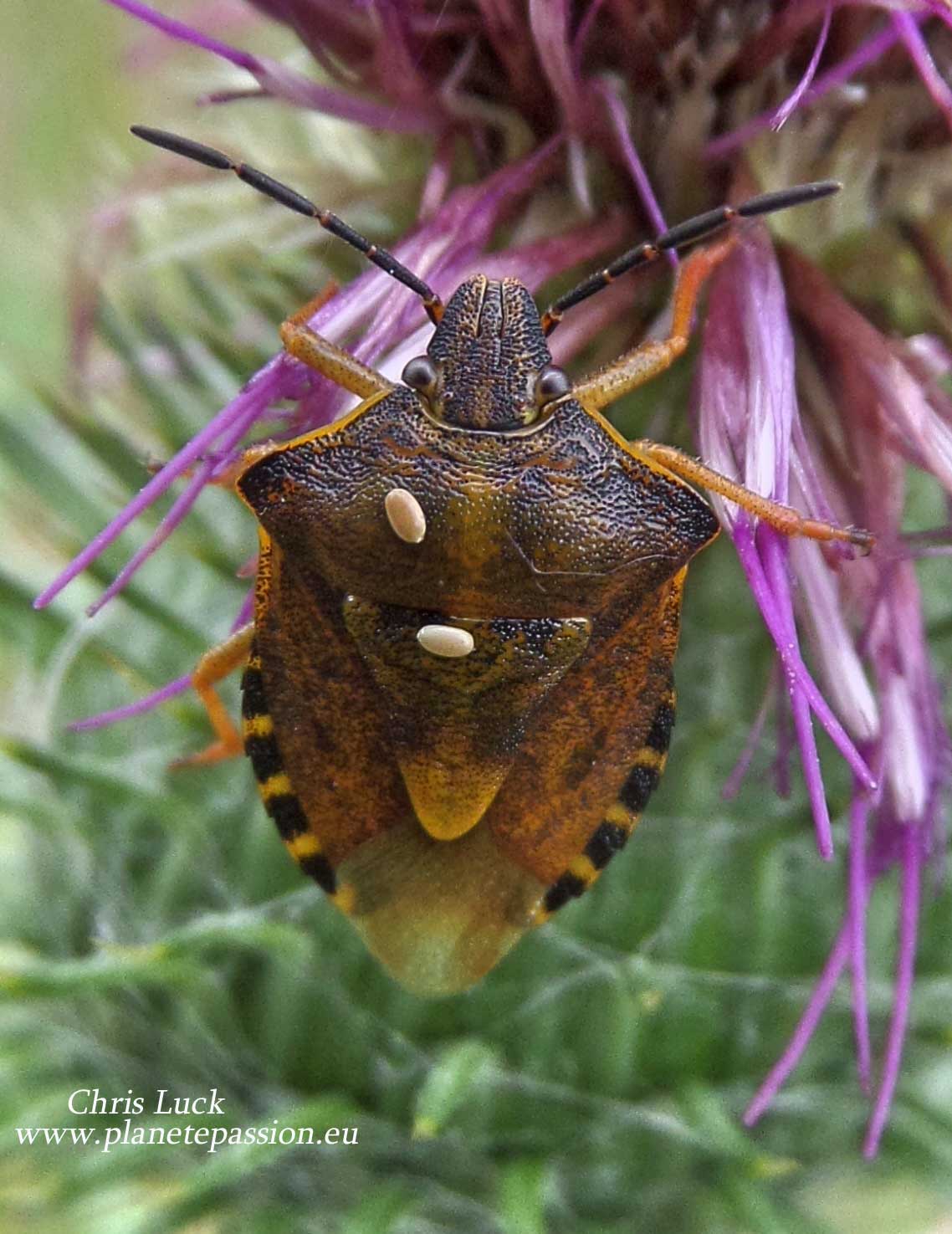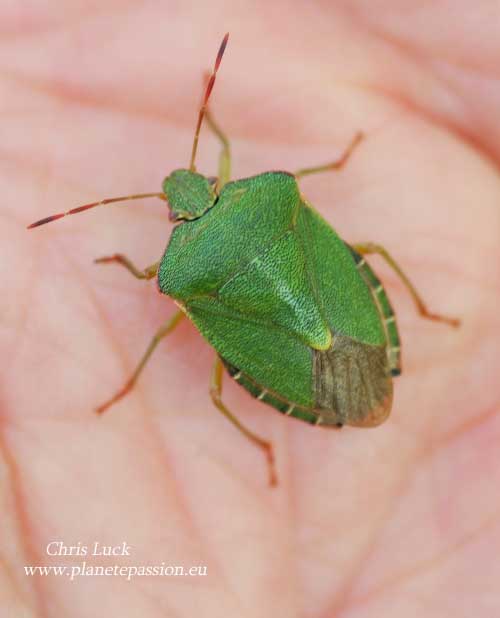




What most of us call Stink bugs and Shield
bugs are part of a large group of insects that are all part of the Order Hemiptera and are called True
bugs. The Order is made up of Stink Bugs, Shield Bugs, Squash Bugs, Seed
Bugs, Plant Bugs, Bed Bugs, Pond Skaters, Cicadas, Water Bugs, Aphids
and Scale Insects.
For people in
The distinguishing feature despite their great
range of differences is that they all have piercing mouthparts with
which they can suck the juices from plants, seeds or animals - usually
plants. These mouthparts are contained in a beak (or rostrum) which is
usually held underneath the body when not in use.

Mottled Shield Bug, Rhaphigaster nebulosa, La punaise nébuleuse or punaise grise.
Mottled Shield Bug is a relatively common species in France associated with hedgerows, woodlands and scrub which they feed on as well as dead insects. Breeding takes place principally in May with one generation a year and the various instars share the same habitat as the adults. They overwinter in as adults in sheltered areas, under vegetation, in cracks in walls or under tree bark and are one of the species that are sometimes to be found in houses. They are also one of the species that can emit an unpleasant smell when disturbed.
**********

Bishop's Mitre Shieldbug, Aelia acuminata, Various common French names: Punaise des blés, Punaise nez-de-rat or Punaise à tête allongée
The Bishop's Mitre Shieldbug is a species that can be found in most parts of France that is associated with tall dry grasslands and as one of the the French names indicates cereal fields. They principally feed on the juices of the seed heads and overwinter undercover of vegetation. They would be unusual to find in houses. There is one generation a year with breeding in April, May, June.
**********

.jpg)

Southern green stink bug, Nezara viridula, Punaise verte ponctuée
The Southern Green Shield bug originated in
**********


Common Green Shieldbug, Palomena prasina, La Punaise Verte
The Common Green Shieldbug is widespread throughout France. There is one generation per year with breeding taking place in May or thereabouts. They feed on many species of deciduous trees and shrubs including fruit trees but rarely cause serious harm. They change colour to brown before over wintering in sheltered places including homes and they can emit a smell when disturbed which some people dislike
*********

Sloe or Hairy Shieldbug, Dolycoris baccarum, La punaise des baies ou pentatome des baies
The Sloe bug is found in all regions of France on hedgerows, woodland edges and open scrub. Feeds on the fruits and seeds of a variety of plants but strangely not Sloe despite its common name however they are hairy. One generation per year with breeding taking place in May or thereabouts and spends winter in sheltered places as adults. Occasionally may enter houses.
**********

Eurygaster austriaca
Eurygaster austriaca is in decline in many places in France presumably due to habitat loss. It is a shieldbug of dry meadows, scrublands, heaths, wastelands as long as there are grasses of more than one meter where they feed on seed heads. They have a preference for warmer regions and are not found at altitudes over 1,400 metres. There is one generation a year and breeding takes place in June. They overwinter as adults. They have no known common English or French names.
**********


Gorse Shieldbug, Piezodorus lituratus, Punaise des genêts
The Gorse Shieldbug is to be found throughout France where it is found mainly on gorse and broom but it also feeds on other plants such as tomatoes, peppers, aubergines and beans. The first pre winter stage of the adult form has reddish markings but they return to green the following spring when a single brood is produced in May.
*********

Rhynocoris (Rhynocoris) annulatus "La Réduve annelée, Le Rhynocoris annelé"
There doesn't appear to be a common English name for this species of Assassin Bug that can be found in many regions of France, although it is more abundant in the south. As can be seen in the photo it is active during the day and preys on other insects that it catches. The eggs are deposited in isolation, or in small groups in summer and they spend winter as juveniles. Can give a painful bite if roughly handled but does not enter houses other than accidentally.
************


Brassica Shieldbug, Eurydema oleraceum, Punaise du chou
The Brassica shieldbug can be found throughout France. They overwinter as adults emerging in early spring. The food plants are various crucifers, often in the flowering stage and are often to be found on mustards and garlic mustard. Does not enter houses and is rarely a pest. This species can have either white, yellow or red markings
More can be found HERE
Masked Hunter Assassin Bug HERE
Gendarmes, (Fire bug), HERE